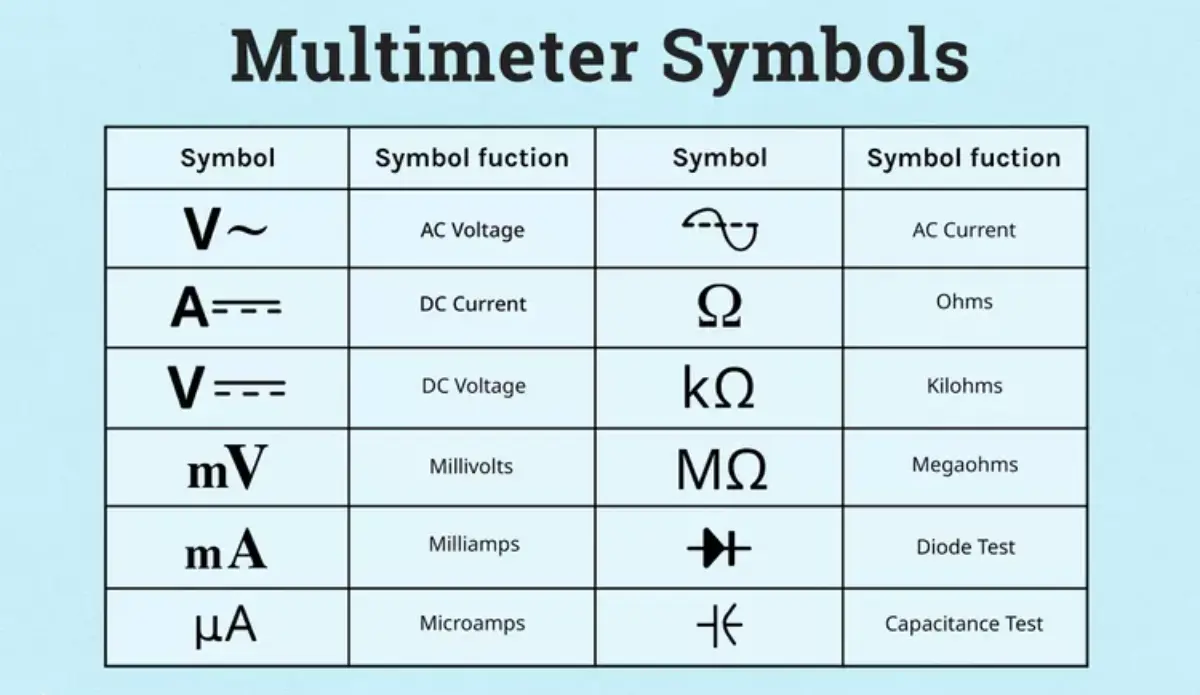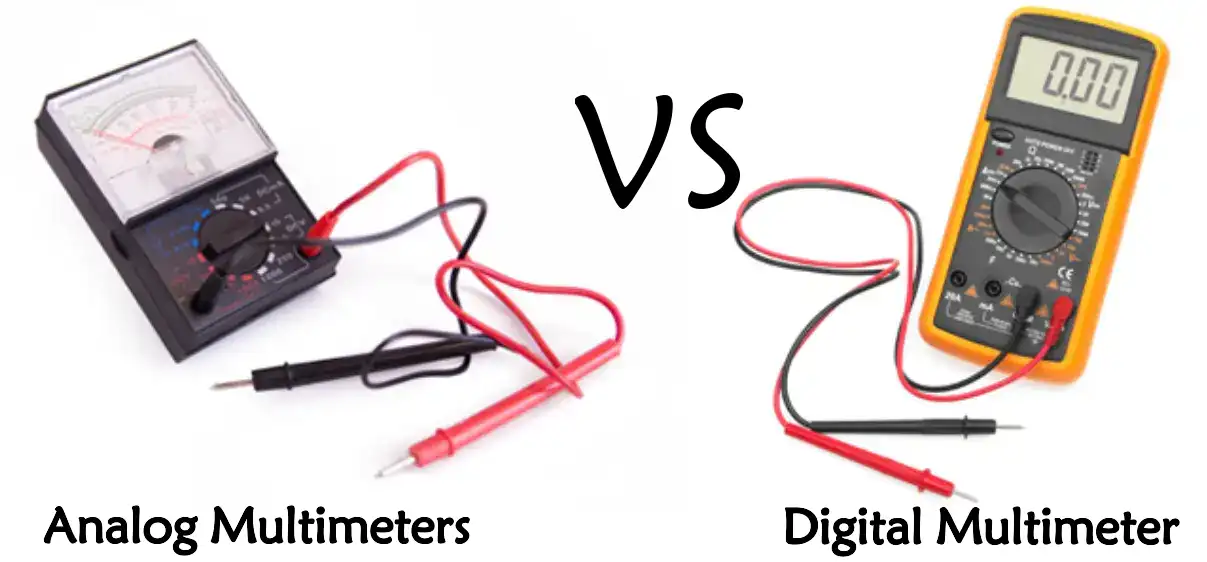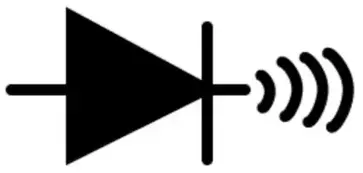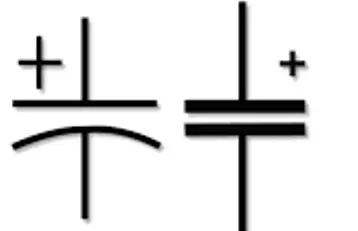

Global high-mix volume high-speed PCBA manufacturer
9:00 -18:00, Mon. - Fri. (GMT+8)
9:00 -12:00, Sat. (GMT+8)
(Except Chinese public holidays)


Global high-mix volume high-speed PCBA manufacturer
9:00 -18:00, Mon. - Fri. (GMT+8)
9:00 -12:00, Sat. (GMT+8)
(Except Chinese public holidays)
HomePage > Blog > Knowledge Base > Decoding the Common Multimeter Symbols
In today's article, we will teach you what multimeter symbols mean. Multimeter symbols stress you out and you don't know what each multimeter symbol means with their giant user manuals, dials, settings buttons, terminals, and leads. There are so many different versions too.
How can anyone understand this? Multimeters use multimeter symbols to show what they're measuring. If you understand these multimeter symbols, you will take correct readings and use your multimeter effectively. So, let's read more about these common multimeter symbols!

In a very simple way, a multimeter identifies electrical issues. For example, you want to know whether a battery is dead or whether a wire is carrying power. In such a case, a multimeter is a standard instrument. You can measure voltage. But what is voltage? Voltage is the electrical potential difference. It occurs between two points in a circuit.
Multimeters have the same basic functions of reading voltage, current, and resistance. Different multimeters will have more advanced functions than things such as capacitors, transistors, diodes, temperature etc. All of these functions are represented using multimeter symbols.
Basically, analog and digital are two
main versions. Analog multimeters use a dial which is horrible to use and
difficult to read and they usually just have a few basic functions. These days,
hardly anyone uses these anymore. Digital multimeters have digital displays.
These are precise,
very easy to use, and usually have a lot more functions. Each function is
selected using multimeter symbols.

Analog multimeters are the original type.
They display readings with the help of a needle. This needle slides through
a scale. The meter face is printed with the scale.
Analog meters are built with a
moving coil format. A moving coil inside a magnetic field interacts with an
electric current. You should notice that it produces a torque that moves the
needle. This is why some electricians like analog. Analog meters can also be
cheaper. They tend to be less complicated in design.
Multimeter
symbols on analog devices are fewer and may be harder to interpret.
Analog meters may read less precisely.
You have to interpolate where the needle is. Parallax error can occur. This is
the angle of viewing reading error. Analog meters are also typically less
accurate than digital meters. They can be more fragile. When the needle moves,
it makes real-time trend observation easy. However, there is another important
point that precision depends on your ability to read the scale correctly.
Digital multimeters are the more modern
designs that incorporate an electronic circuit. That’s because they also show
readings in numbers. They are displayed on a digital screen. This display is
typically an LCD. These devices convert the measured value in digital signal.
A digital multimeter is based on an
electronic circuit. The measured value is then converted to a digital signal,
which an analog-to-digital converter (ADC) processes. This part shows the
output of the ADC, which is displayed on an LCD. The readings are direct and
unambiguous. Multimeter
symbols on DMMs are clearly marked and easy to select.
Digital multimeters are very accurate.
The readings are precise and clear. There is no parallax error. Digital
readouts are easily understood. They frequently include auto-ranging
capabilities. This
meter automatically selects the correct range. Each of these features is linked
with specific multimeter symbols.
In digital meters, it will be very hard
for you to observe the change in trend. The reason is, the changes are shown as
number shifts, which may make them less interpretable visually for quick
adjustments. You know that older digital meters are slow to generate response
time. However,
modern DMMs are pretty fast and give accurate readings. But the low side is its
higher cost. Still, all measurements depend on your ability to use the
multimeter symbols correctly.

The
continuity symbol can test for a complete electrical circuit. It verifies the
circuit's integrity. At times, it’s just a diode symbol.
So this continuity function incorporates a low-voltage signal. What is its
purpose? It is used to detect a complete circuit.
If the resistance is below a certain
threshold, the meter emits a beep. If resistance is low, a beep indicates that.
This tone indicates that continuity remains. If no beep is heard, the circuit
is open. Does this test employ Ohm's Law (V=IR)? A slight V across a low R
creates I. The multimeter senses the current. It then triggers the beep.
Broken wires are typically found with
continuity testing. It also takes inventory of broken switches. Connections
made with solder can be checked. It is a quick binary test. It depicts either
continuous or not continuous. The aim is not to measure accurately.
Voltage symbols refer to electrical potential differences. It is important to learn for you that voltage is symbolized by 'V'. It is the thing that causes the electric charge to move.

DC Voltage Symbol: V with a straight line and dashes Or even just V with a straight line. This is for the measurement of Direct Current (DC) Voltage. The polarity of DC voltage is constant. Terminals remain at the constant electric potential.
Current only flows in one direction. Batteries provide DC voltage. So do DC power supplies and rectified AC. When doing DC voltage, the probe polarity counts. The red probe is positive. Black test leads are negative or typical. Units are Volts (V). Ranges include mV, V, and kV.

AC Voltage Symbol: It is 'V' with a wavy line. It signifies Alternating Current (AC) Voltage measurement. When it comes to AC voltage, the polarity is constantly changing. It is typically sinusoidal. Current flow reverses direction at times.
AC voltage is used in power grids. The most common form of electric power is AC voltage, which power plants produce. Polarity is not as crucial with simple AC voltage measurement. But polarity may matter for specialized uses. Units are Volts (V) RMS.
The Current Symbol is 'A'. Now, the current is the rate of flow of electric charge. It is the amount of charge that passes through some point per unit of time. Current: It is measured in Ampere(A) or Amp. [Multimeters | DC and AC Current Measurements]

The DC Current Symbol is 'A' with a straight line and dashes. Or it can be 'A' with a straight line. It is used as DC Current measurement. DC current is the flow of charge in one direction. Electrons move one way. It is well known that DC voltage sources create DC currents.
DC current measurement requires proper probe orientation. Why it is important because it significantly affects reading. Current flows into the positive terminal. It exits a negative terminal. Units are Amperes (A). Ranges are µA, mA, and A.

The AC Current Symbol is 'A' with a sine wave. It is the abbreviation of Alternating Current (AC). Current measurement: AC current is a charge flow that goes in both directions. Electrons swing back and forth. The AC voltage sources drive the AC current. The measurement of AC current must also be done in series. Units are Amperes (A) RMS. RMS stands for root mean square. Ranges are µA, mA, and A.

Omega, Ω indicates Resistance. Symbol Resistance is how resistance measures oppose current flow. It tells how difficult it is for electrons to move. Ohm (Ω) is the unit for Resistance. Resistance is a property of a material. It gains from the interaction of electrons with the structure of the material.
So one thing is noticeable here that if you see resistance is higher, it means the current flow will be low. Now, which factors influence this resistance? These are material, size, and temperature.
You can calculate the resistance by applying the following formula. Ohm's Law (R = V/I). The units are Ohms (Ω). Ranges are Ω, kΩ, and MΩ.

If you have a multimeter, this symbol is shown in 'F,' 'CAP,' style. There could be parallel lines | | curved plates () also. Capacitance is a measure of an ability to store charge. It is for capacitors. A measure of capacitance is the charge stored per voltage. The unit is Farad (F).
The capacitor geometry dictates capacitance. The dielectric properties also are essential. Capacitors provide storage via an electric field. This space is located between the conductive plates. The field is generated by applying voltage. Capacitance is based on the area of the plates. Distance between plates does matter.
The multimeter charges the capacitor. It relates to the voltage rise with time. This determines capacitance. Some multimeters can measure in-circuit. Accuracy could become less due to parallel paths. Simultaneously, units are Farads (F).
Multimeter symbols are essential for making accurate measurements. Symbols help you to choose the appropriate measurement type.
If not configured correctly, the results will be all wrong. Misdiagnosis of electrical problems can result from incorrect readings. This incurs time spent in resolving the issue.
Selecting the wrong range may even damage the multimeter itself. An example of that is the current being measured using a voltage range, which overloads the meter. Such mistakes can also be avoided by understanding symbols.
Inadequate and wrong voltage measurements mean there are higher chances of voltage fluctuation. Incorrect present setups can form short circuits. But short circuits create sparks, heat, and fire hazards. It helps you for selection of safe measurement ranges. These also manage to make sure probes are correctly connected in each test. Many safety protocols rely on correct symbol reading.
The better you know symbols, the more efficient you are with electrical work. You choose locations based on symbols used for identification. No guesswork or hunting through settings is required. Ultimately, you get swift testing and diagnostics.
Reduced time to troubleshoot means quicker recovery. In the professional environment, time is money. One of the critical skills is learning to use a multimeter efficiently. The multimeter is an interface graphed in symbols. If you are fluent in this language, you are a proficient user.
What is more, symbols ensure a degree of consistency across multimeters. Basic symbols are the same regardless of make and model. After learning core symbols, one can use different multimeters.
To sum up, understanding symbols is not an optional skill. It is essential for precise measurements. It has a very key role in electric safety. This improves functional efficiency in electrical elements. And it creates universality between multimeter machines.
As such, these symbols are an investment in competence and safety. It enables the confident use of the multimeter effectively.
It would help not only in understanding multimeter symbols but also in taking accurate and safe electrical measurements. Understanding symbols helps avoid setting the wrong options and potential errors. Both analog and digital multimeters have strengths and weaknesses.

Assembly Enquiry
Instant Quote
Phone contact

+86-755-27218592
In addition, we've prepared a Help Center. We recommend checking it before reaching out, as your question and its answer may already be clearly explained there.
Wechat Support

In addition, we've prepared a Help Center. We recommend checking it before reaching out, as your question and its answer may already be clearly explained there.
WhatsApp Support

In addition, we've prepared a Help Center. We recommend checking it before reaching out, as your question and its answer may already be clearly explained there.
